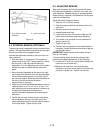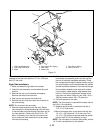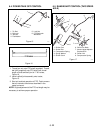
7 -25
To avoid damage to the rear pin plate bushing, it is not
recommended that planetary system be further
disassembled unless definite problems exist.
If an unreasonable amount of play is noticed in the
system:
1. Inspect orbit gear pins and bushings for wear.
2. Inspect the orbit gear carrier bushing for wear.
3. Check for worn or damaged gearing.
7.6 DIFFERENTIAL
Before assuming internal Swiftamatic difficulties,
inspect the external linkage and parts for binding.
Carefully check the following:
1. Check linkage for binding, sheared spring pin,
loose nuts or debris build up.
2. Check to see that the shifter arm is not binding on
the stationary pivot.
3. Check to see that the clutch sliding pivot is free.
4. Check to see that the extension spring is in place.
5. Check stationary clutch bolt. Be sure it is not
sheared.
6. Raise tractor wheels. Turn one wheel by hand. The
other wheel should turn in the opposite direction.
Check for tightness and rough spots while turning.
7.7 DIFFERENTIAL REMOVAL
1. Drain oil from transmission.
2. Raise tractor and remove wheels.
3. Remove right hand wheel hub.
4. Disconnect Swiftamatic shift linkage.
5. Remove right hand axle housing with axle.
6. Carefully examine the shifting yoke, shifting clutch,
stationary clutch and clutch housing. Particular
attention should be given to see that the stationary
clutch is properly secured against rotation. Also
make sure the shifting clutch slides freely on the
shifting gear.
7. If no discrepancies have been found at this point or
if the failure is obviously a part of the differential
assembly, remove the differential assembly.
8. Remove left hand wheel hub.
9. Remove left hand axle housing with axle.
Figure 20
1. Ring Gear and Bushing
2. Planet Gear Carrier
3. Internal Orbit Gear
4. External Orbit Gear
1
2
3
4
Figure 21
1. Stationary Pivot
2. Shifting Yoke
3. Clutch Sliding Pin
1
2
3
Figure 22
1. Straight Axle
2. Axle Housing
3. End Plate
1
2
3


















